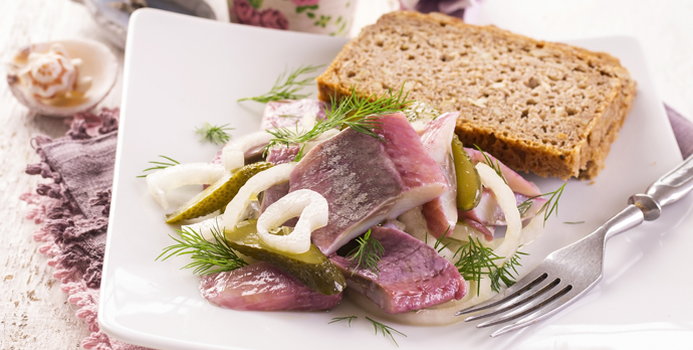You have probably heard the various well-established health benefits associated with the Mediterranean diet, but what you may not be privy to are the advantages of eating like a Scandinavian. Have you heard of the Nordic diet?
The Nordic diet is based on traditional foods from Iceland, Finland, Denmark, Sweden, and Norway. Much like the Mediterranean diet, the Nordic diet has been associated with a reduced risk of type 2 diabetes, heart disease, and Alzheimer’s disease. Are you trying to lose weight? The Nordic dietary pattern is also correlated with weight loss. In fact, in Sweden (one of the Nordic countries) the rate of obesity is as low as ten percent — much lower than the dangerously high obesity rate in the U.S. Additionally, when compared to the Mediterranean diet, the Nordic diet is lauded as healthier, much more convenient, and just as scrumptious.
The Nordic diet is built on the Baltic Sea Diet Pyramid. This eating pattern focuses primarily on vegetables and fruits, particular vegetables of Northern Europe, including cabbages, root veggies, and peas, as well as berries and seasonal fruits, such as cherries, strawberries, blueberries, cloudberries, and lingonberries (similar to currants). Another component of this healthy eating pattern is its inclusion of high-fiber whole grains, particularly barley, whole oats, and whole-grain rye. Next is low-fat and fat-free dairy products, such as skim milk, yogurt, and cheese. Also included are fatty fish (mackerel, trout, salmon, herring) and leaner types of fish (haddock, halibut, and cod) and legumes. They eat only very limited amounts of processed foods, red meat, processed meat, chicken, and sweets.
What is termed the “new Nordic diet” aims to capture long-standing Nordic cooking traditions and principles while also emphasizing creating unique flavors, extending the shelf life of available local products throughout the winter months (think pickling foods), and advancing food’s nutrient content. The new Nordic diet was developed in conjunction with chefs hailing from the two-star Michelin, world-famous gourmet restaurant noma in Copenhagen.
Why Nordic is So Noteworthy
The Nordic diet has been built on the Baltic Sea Diet Pyramid and scientists believe there are several reasons it is so healthy.
Plant-Based — What takes up the most space on the plates in Nordic countries is nutrient-dense produce. Locally-grown, seasonal vegetables and fruits are the stars of the plate, while small amounts of high-quality but affordable fish are added to boost flavor. All of their carbohydrates are made from high-quality, nutrient-dense ingredients including breads, cereals, and crackers made from my whole-grain rye, oats, and barley. Whole-grain rye is eaten almost daily.
Fiber -- The Nordic dietary pattern has more than twice the dietary fiber than the average diet in the United States because of the plethora of plant foods that make up their meals and snacks.
Sustainability — Eating local, fresh ingredients is one the core principles of this eating pattern. The Nordic diet centers on ingredients that are easily grown in the colder climates of the Nordic regions of Northern Europe. This eating pattern also recommends eating organic vegetables and fruits whenever feasible, eating more foods from wild landscapes, and avoiding food additives.
Fish — Both fatty fish and white fish are consumed often in Nordic regions. The classic Nordic diet staple of pickled herring is consumed several times a week. Fish the main protein consumed in the Nordic diet and the kinds they opt for are both incredibly healthy and very affordable. Loaded with protein, antioxidants, and omega-3 fatty acids, the Nordic diet centers on eating cheap but delectable fish such as herring, mackerel, salmon, and trout.
Healthy Oil -- Canola (rapeseed) oil is the most common type of fat used in the Nordic diet and actually contains more omega-3 fatty acids and vitamin E than the Mediterranean diet’s favorite fat--olive oil. The Nordic diet does not derive much fat from animal sources.
Healthy Food Culture & Environment — In Nordic countries, they cook meals from scratch. There is not a rampant fast-food culture, nor is convenience food so prevalent. Sitting down and eating meals slowly at the table with family and friends is a vitally important part of their food culture.
Less Red & Processed Meats, Less Processed Foods — Scandinavians prioritize seafood and fish and rarely eat red meat or processed meats. They also avoid processed foods and convenience foods, which naturally makes this diet lower in total fat and sugar than most western diets.
Herbs & Spices — To add bold flavors without tons of fat or sugar, the Nordic diet utilizes a lot of dill, chives, thyme, fennel, cardamom, parsley, fennel, and juniper berries.
Making Your Diet More Nordic
Of course, the Nordic diet succeeds for those living in the Scandinavian region, but you can apply these dietary principles to your diet regardless of where you call home.
*Eat fresh, locally-grown, organic produce when it is in season. Blanch or pickle extra veggies when they’re abundant during the summer months in order to still enjoy them during winter. Freeze berries when they're in season to use year-round.
*Replace two servings of red meat or processed meat with fish each week.
*Drizzle canola oil over your veggies and toast rather than butter.
*Start your day with whole-grain rye toast or a hearty bowl of oatmeal or barley.
*Make half of your plate vegetables, particularly cruciferous veggies, such as cabbage or kale.
[Image via Shutterstock]



